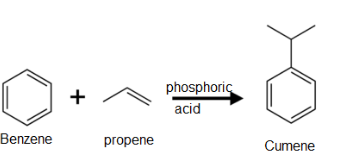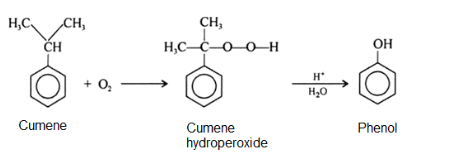
How do you prepare phenol from benzene?
Answer
466.2k+ views
Hint: Conversion of benzene to phenol means introduction of hydroxyl group in the benzene ring. This introduction can be done with various processes and mechanisms. The Majority of the processes involved in this conversion are two steps or multi-steps processes.
Complete step-by-step answer:Phenol can be prepared from benzene in many ways. Here we will discuss two major ways through which the reaction can proceed.
1. From chlorobenzene: Benzene undergo halogenation when it is treated with chlorine in presence of Lewis catalyst such as anhydrous
The final reaction is as follows:

Chlorobenzene so formed can be converted to phenol as follows
Chlorobenzene on heating with 10 percent aqueous sodium hydroxide solution at about

2. From Cumene
Phenol is prepared commercially from cumene. Cumene is prepared by Friedel craft alkylation of benzene with propene in the presence of phosphoric acid at 523K.

Cumene is oxidized in the presence of air to cumene hydroperoxide which upon subsequent hydrolysis with sulfuric acid gives phenol and propanone

Note: It should be noted that optimum temperature and proper catalyst needs to be used while performing the reactions. Also, there are various other methods through which the phenol can be prepared, but the most commercial method is the preparation with the help of cumene.
Complete step-by-step answer:Phenol can be prepared from benzene in many ways. Here we will discuss two major ways through which the reaction can proceed.
1. From chlorobenzene: Benzene undergo halogenation when it is treated with chlorine in presence of Lewis catalyst such as anhydrous
The final reaction is as follows:

Chlorobenzene so formed can be converted to phenol as follows
Chlorobenzene on heating with 10 percent aqueous sodium hydroxide solution at about

2. From Cumene
Phenol is prepared commercially from cumene. Cumene is prepared by Friedel craft alkylation of benzene with propene in the presence of phosphoric acid at 523K.

Cumene is oxidized in the presence of air to cumene hydroperoxide which upon subsequent hydrolysis with sulfuric acid gives phenol and propanone

Note: It should be noted that optimum temperature and proper catalyst needs to be used while performing the reactions. Also, there are various other methods through which the phenol can be prepared, but the most commercial method is the preparation with the help of cumene.
Recently Updated Pages
Master Class 12 Business Studies: Engaging Questions & Answers for Success

Master Class 12 English: Engaging Questions & Answers for Success

Master Class 12 Social Science: Engaging Questions & Answers for Success

Master Class 12 Chemistry: Engaging Questions & Answers for Success

Class 12 Question and Answer - Your Ultimate Solutions Guide

Master Class 11 Economics: Engaging Questions & Answers for Success

Trending doubts
Draw a labelled sketch of the human eye class 12 physics CBSE

a Tabulate the differences in the characteristics of class 12 chemistry CBSE

Which one of the following is a true fish A Jellyfish class 12 biology CBSE

Why is the cell called the structural and functional class 12 biology CBSE

Differentiate between homogeneous and heterogeneous class 12 chemistry CBSE

Write the difference between solid liquid and gas class 12 chemistry CBSE




